Обеспечение антикоррозионной защиты и поддержание её высоких эксплуатационных характеристик являются одними из наиболее важных факторов, гарантирующих надёжность и длительный срок службы трубопровода. Комплексная программа мероприятий по антикоррозионной защите осуществляется на всех этапах — как производства труб, так и строительства и эксплуатации трубопроводов.
Roofing bitumen BNK Ecobit - impregnating and covering, used for the production of roofing materials. Roofing bitumen is also used for the production of bitumen mastics, bitumen primer, hydrostekloizol, etc. Construction bitumen is produced in briquettes of 20-35 kg.
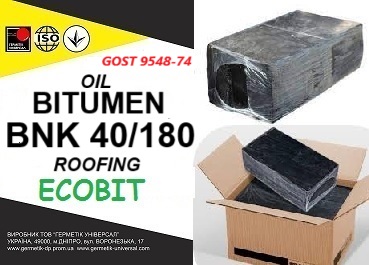
Roofing bitumen BNK 40/180 Ecobit (Code: BT-000004) Roofing bitumens are used to produce roofing materials. They are divided into impregnating and covering (respectively for impregnating the base and obtaining a covering layer). Roofing bitumens BNK 40/180 Ecobit and BNK 45/190 Ecobit are used to impregnate the base in the production of roofing and waterproofing materials. Roofing bitumen BN 90/30 Ecobit (BNK 90/30 Ecobit) is used to obtain a covering layer of these materials.
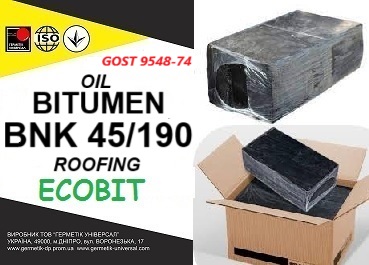
Roofing bitumen BNK 45/190 Ecobit (Code: BT-000005) Roofing bitumens are used to produce roofing materials. They are divided into impregnating and covering (respectively for impregnating the base and obtaining a covering layer). Roofing bitumens BNK 40/180 Ecobit and BNK 45/190 Ecobit are used to impregnate the base in the production of roofing and waterproofing materials. Roofing bitumen BN 90/30 Ecobit (BNK 90/30 Ecobit) is used to obtain a covering layer of these materials.
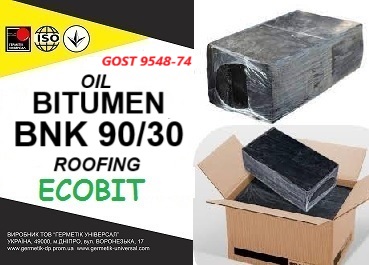
Roofing bitumen BNK 90/30 Ecobit (Code: BT-000006) Roofing bitumens are used to produce roofing materials. They are divided into impregnating and covering (respectively for impregnating the base and obtaining a covering layer). Roofing bitumens BNK 40/180 Ecobit and BNK 45/190 Ecobit are used to impregnate the base in the production of roofing and waterproofing materials. Roofing bitumen BN 90/30 Ecobit (BNK 90/30 Ecobit) is used to obtain a covering layer of these materials.
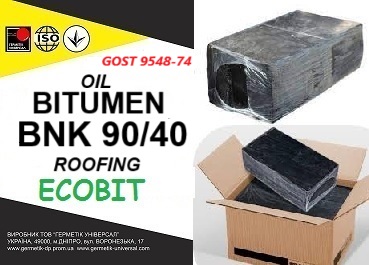
Roofing bitumen BNK 90/40 Ecobit (Code: BT-000007) Roofing bitumens are used to produce roofing materials. They are divided into impregnating and covering (respectively for impregnating the base and obtaining a covering layer). Roofing bitumens BNK 40/180 Ecobit and BNK 45/190 Ecobit are used to impregnate the base in the production of roofing and waterproofing materials. Roofing bitumen BN 90/30 Ecobit (BNK 90/30 Ecobit) is used to obtain a covering layer of these materials.
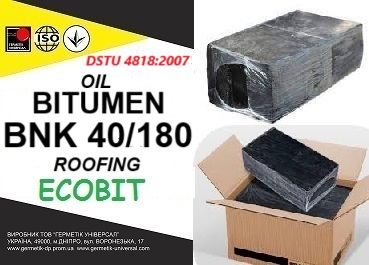
Roofing bitumen BNK 40/180 Ecobit (Code: BT-000004/1) Roofing bitumens are used to produce roofing materials. They are divided into impregnating and covering (respectively for impregnating the base and obtaining a covering layer). Roofing bitumens BNK 40/180 Ecobit and BNK 45/190 Ecobit are used to impregnate the base in the production of roofing and waterproofing materials. Roofing bitumen BN 90/30 Ecobit (BNK 90/30 Ecobit) is used to obtain a covering layer of these materials.
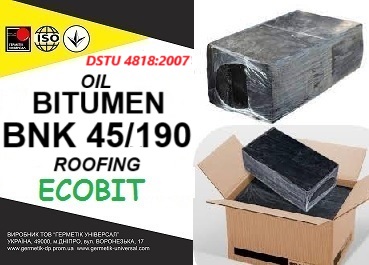
Roofing bitumen BNK 45/190 Ecobit (Code: BT-000005/1) Roofing bitumens are used to produce roofing materials. They are divided into impregnating and covering (respectively for impregnating the base and obtaining a covering layer). Roofing bitumens BNK 40/180 Ecobit and BNK 45/190 Ecobit are used to impregnate the base in the production of roofing and waterproofing materials. Roofing bitumen BN 90/30 Ecobit (BNK 90/30 Ecobit) is used to obtain a covering layer of these materials.
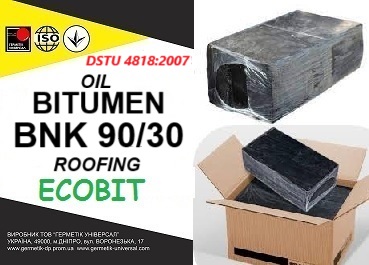
Roofing bitumen BNK 90/30 Ecobit (Code: BT-000006/1) Roofing bitumens are used to produce roofing materials. They are divided into impregnating and covering (respectively for impregnating the base and obtaining a covering layer). Roofing bitumens BNK 40/180 Ecobit and BNK 45/190 Ecobit are used to impregnate the base in the production of roofing and waterproofing materials. Roofing bitumen BN 90/30 Ecobit (BNK 90/30 Ecobit) is used to obtain a covering layer of these materials.
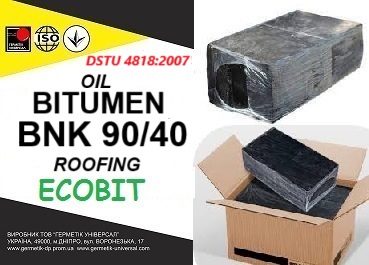
Roofing bitumen BNK 90/40 Ecobit (Code: BT-000007/1) Roofing bitumens are used to produce roofing materials. They are divided into impregnating and covering (respectively for impregnating the base and obtaining a covering layer). Roofing bitumens BNK 40/180 Ecobit and BNK 45/190 Ecobit are used to impregnate the base in the production of roofing and waterproofing materials. Roofing bitumen BN 90/30 Ecobit (BNK 90/30 Ecobit) is used to obtain a covering layer of these materials.
Roofing bitumens have a higher softening temperature (85 - 95 C) and a smaller depth of needle penetration, while for insulating bitumens the extensibility index is important. It is usually prepared from residual bitumen of low density. Roofing bitumen contains a certain amount of cycloparaffin and paraffin hydrocarbons and approximately 30% asphaltenes. The ratio of carbon and hydrogen in it is also increased; as a result, the dissolving capacity of such bitumens decreases and the mutual attraction of asphaltenes increases.
Asphaltenes also attract heavy aromatic components, but the probability of other components joining with these aggregates is very low. Such a system can be considered at high temperatures as a concentrated solution of a solid substance in an oil medium. When cooled, the asphaltenes precipitate and form complexes that resemble crystallites. This process is so rapid that the aggregates are extremely small; this corresponds to the general law that the ratio of the surface of a crystal to its volume is greatest at high growth rates.
An equally important factor determining the quality of bitumen is the method of its production. The production of roofing bitumen in the practice of oil refining both in Ukraine and abroad is carried out mainly by oxidation of the corresponding oil residual products. In Ukraine, the main amount of oxidized bitumen is produced in batch cubes.
For most bitumens, the ability to water saturation is revealed already during the first day. Therefore, the technical requirements of GOST 9812 - 61 for petroleum roofing bitumens are limited to standardization of daily water saturation of bitumen. Studies of bitumens show that their physical and chemical properties are related to the fractional composition.
Knowledge of the optimal ratios of individual components of raw materials, as well as colloidal changes occurring during the production of bitumen, makes it possible to take a more qualified approach to the selection of raw materials and the method of processing them to obtain high-quality bitumen.However, the quality requirements for oils for the production of insulating bitumens differ significantly from the requirements for them for obtaining road bitumens. This is due to the specifics of their application, as well as the difference in the structural and colloidal state of viscous and solid bitumens.




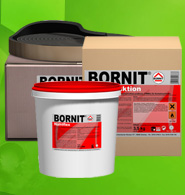
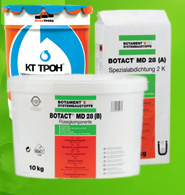
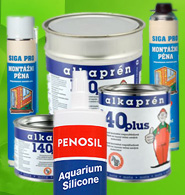
 Ukraine
Ukraine Kazakhstan
Kazakhstan Belorussia
Belorussia Moldova
Moldova Russia
Russia Uzbekistan
Uzbekistan Azerbaijan
Azerbaijan Armenia
Armenia Georgia
Georgia Kyrgyzstan
Kyrgyzstan Turkmenistan
Turkmenistan Tajikistan
Tajikistan Poland
Poland Hungary
Hungary Romania
Romania Bulgaria
Bulgaria Czech
Czech Slovenia
Slovenia Slovakia
Slovakia Serbia
Serbia Croatia
Croatia Montenegro
Montenegro Bosnia
Bosnia Estonia
Estonia Latvia
Latvia Lithuania
Lithuania